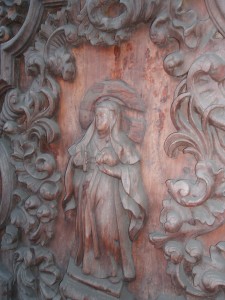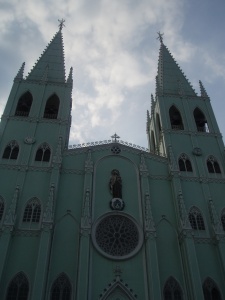posted by: Prime Sarmiento
Growing up in a devout Catholic family means spending a lot of time hearing mass in any place where there’s a Catholic church. And in a predominantly Catholic Philippines, that’s very easy as Filipinos don’t only go to church on Sundays- the traditional day of obligation. For people like my mother, every day is church day, with each day dedicated to a specific church (i.e. Wednesdays are devoted to Baclaran, to say the novena to Our Lady of Perpetual Help, while Friday means a trip to Quiapo to pay homage to the Black Nazarene.
Which is why the annual Visita Iglesia – wherein our family visits several churches in Manila during Maundy Thursday, something like a mini pilgrimage – can be tiresome (and boring) for this not-really-practicing-Catholic. We’ve done that for the past few years, but it was only recently that I managed to enjoy it.
Aside from the fact that I’m more spiritual these days (the story behind that constitutes another blog post), my new found appreciation for the Visita Iglesia also stems from my growing interest with heritage sites in the Philippines. If I can visit Buddhist and Hindu temples in Thailand and Nepal, why can’t I see the beauty of some of our churches here?
So if you find yourself stuck in Manila for the Holy week, I suggest that you do a Visita Iglesia, if only because viewing works of art can be such a spiritual experience.
Here are some churches that you might want to see:
a. Manila Cathedral: the seat of the Archbishop of Manila, the minor basilica is dedicated to Our Lady of the Immaculate Conception. It was was established in the 16th century inside the Intramuros – the centuries old Walled City where the Spanish colonial government used to be based. The church also serves as a resting place for former prelates who have served the Archdiocese of Manila (including Rufino Jiao Santos, the first Filipino Cardinal and Jaime L. Cardinal Sin) and was the site of the funeral of two former Philippine Presidents: Carlos P. Garcia and Corazon Aquino.
2. San Agustin Church: also in Intramuros, this church is the first religious structure built in the island of Luzon by the Spanish colonial government. The church is a very popular venue for weddings, as it is perhaps one of the most beautiful churches in the Philippines. From its ornately carved wooden doors that depict floras and religious images to gilded altars holding statues of saints to grand chandeliers and a dome decorated with trompe l’oeil– this church has everything to satisfy those with passion for interiors and decorative arts. It also has a museum which serves as repository for religious artifacts and centuries-old artworks.
3. Minor Basilica of the Black Nazarene: or more popularly known as the Quiapo church, this is perhaps one of the most known Philippine churches as it is home to the Black Nazarene. The much venerated statue of Jesus Christ has inspired so much devotion among the faithful that every year, thousands join the procession held in January 9 in honor of the Black Nazarene.
4. San Sebastián Church: The National Shrine of Our Lady of Mt. Carmel was built in 1891 and is renown for its architectural features. It is the only all-steel church in Asia, with its prefabricated steel sections made in Belgium, and was built by Spanish architect Genaro Palacios to be a fire and earthquake-resistant structure. It was declared a National Historical Landmark in 1973 and was included in the Tentative List for possible designation as a World Heritage Site.
5. The Parish of the Holy Sacrifice: the landmark Catholic chapel in the University of the Philippines campus in Diliman, Quezon City is perhaps the only church in the country which was designed and decorated by several of the Philippines most esteemed artists.
The round chapel was designed by the late National Artist for Architecture, Leandro Locsin. The designs on the floor were made by Arturo Luz while the mural on the walls depicting the the Stations of the Cross were done by Vicente Manansala and Ang Kiukok. Napoleon Abueva made the double-sided crucifix and altar base. All of these artists are also National Artist awardees.
In 2005, The church was recognized as a National Historical Landmark and a Cultural Treasure by the National Historical Institute and the National Museum, respectively.


